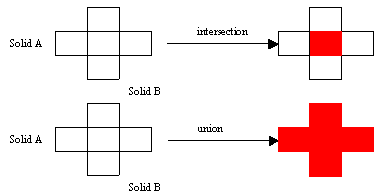TRIBOOL2
Computes a grid based union or intersection of two triangulations. Tribool2 can also smooth a triangulation according to a 3D grid.
Usage:
|
|
Where:
|
Option |
Description |
|---|---|
|
|
Refers to the triangulations that are to be used in the Boolean operation. The extension |
|
|
|
|
|
The The If not specified, inside a solid or below a surface is assumed. |
|
|
The inputs are two triangulations and the output is a union (
|
|
|
The Choosing a reasonable grid cell size is important for getting good answers from For large triangulations, a reasonable grid cell size is the dimension divided by 100. For example, if the triangulations extend from 1100 to 35000 in the Z direction, then a |
|
|
If only one triangulation is supplied, |
Example 1
The following diagrams use section views of a topography triangulation and a pit triangulation. For a surface, an imaginary vertical line is drawn from the outer edges of the triangulation.

Figure 1: Imaginary Lines
The vertical lines generate the "solid" used in the boolean operation. The hatching patterns show points considered to be inside the imaginary solid.

Figure 2: Points Inside Imaginary Solid
All examples are entered on one line with each part being separated by a space.
tribool2 topography.00t -and pit.00t -delta 100 100 10 -output inttopopit.00t
Creates a smoothed triangulation, with a 100 by 100 by 10 resolution, called inttopopit.00t at the intersection of the two input triangulations (topography.00t and pit.00t). Only points inside topography.00t and pit.00t will be included in the final triangulation.

Figure 3: Input Triangulations
This will generate the following triangulation (inttopit.00t).

Figure 4: Final Triangulation
tribool2 topography.00t -or pit.00t -delta 100 100 10 -output uniontopopit.00t
Constructs the union of the two triangulations (points included would be inside one or the other triangulation) and creates the output triangulation uniontopopit.00t.
tribool2 topography.00t -and -outside pit.00t -delta 100 100 10 -output outtopopit.00t
Takes points outside pit.00t and intersects them with the points inside topography.00t and creates the output triangulation outtopopit.00t.
tribool2 topography.00t -delta 100 100 10 -output toposmooth.00t
Smooths an input triangulation to a desired resolution. This has the effect of creating a gridded triangulation at the desired resolution.
tribool2 s1.00t -or s2.00t -output out.00t
Computes the union of two solids (s1.00t and s2.00t), i.e. the output triangulation contains both input triangulations.
tribool2 s1.00t -and s2.00t -output out.00t
Computes the intersection of two solids (s1.00t and s2.00t), i.e. the output triangulation consists of the part inside both input triangulations.
tribool2 s1.00t -and -outside s2.00t -output out.00t
Removes a solid triangulation (s2.00t) from a surface triangulation (s1.00t).
tribool2 s1.00t -or s2.00t -output out.00t
Adds a solid triangulation (s1.00t) to a surface triangulation (s2.00t).
tribool2 -below s1.00t -and -above s2.00t -output between.00t
Finds the solid between two surfaces (s1.00t and s2.00t). S1.00t is above s2.00t.
tribool2 s1.00t -and -above s2.00t -delta 100 100 10 -output out.00t
Finds the portion of a solid (s1.00t) above a surface (s2.00t) using a 100 by 100 by 10 grid cell size.
tribool2 s1.00t -and -above s2.00t -delta 20 20 1 -output out.00t
Finds the portion of a solid (s1.00t) above a surface (s2.00t) using a 20 by 20 by 1 grid cell size. This is the same as the above example but the output will be larger and more detailed.
tribool2 s1.00t -delta 10 10 5 -output s1new.00t
Filters a triangulation (s1.00t) by a grid cell size of 10 x 10 x 5.


